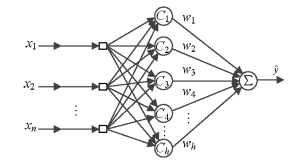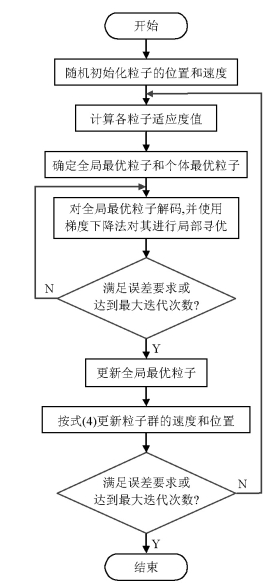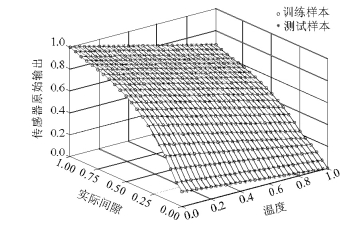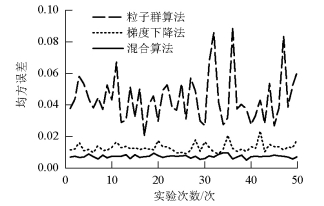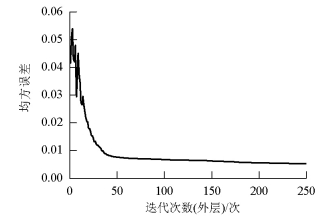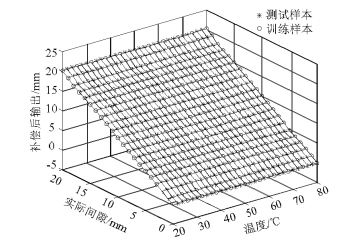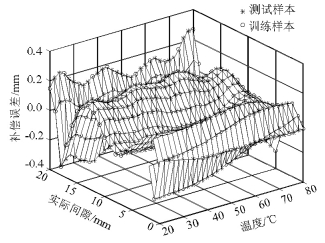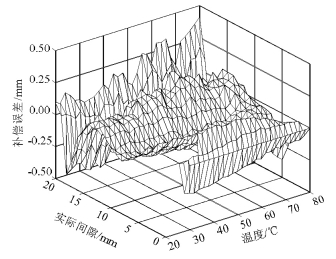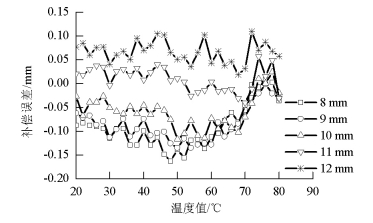Temperature Compensation of Maglev Vehicle Gap Sensor Based on RBF-NN Optimized by PSO
-
摘要: 针对高速磁浮列车悬浮间隙传感器的温度漂移现象,建立了基于RBF(radial basis function)神经网络的间隙传感器温度补偿模型.通过对全局最优粒子执行梯度下降寻优,将粒子群优化算法与梯度下降算法结合得到一种寻优能力更强的混合算法,并将该方法用于RBF温度补偿模型参数优化,提高了间隙传感器的补偿精度,最后,使用现场可编程门阵列FPGA(field-programmable gate array)实现了该补偿模型并进行了实验.实验结果表明:该方法能够较好地对间隙传感器进行温度补偿,补偿后的传感器输出不受环境温度影响,全量程范围内最大误差为0.45 mm,8~12 mm工作间隙范围内误差为0.16 mm.Abstract: In order to solve the temperature drift problem of a maglev vehicle gap sensor, a temperature compensator based on RBF-NN (radial basis function neural network) was designed to compensate the temperature drift error. A hybrid algorithm was proposed to combine PSO (particle swarm optimization) algorithm with gradient descent algorithm. In the proposed algorithm, the global optimal particle of the PSO was optimized by the gradient descent method. The hybrid algorithm has stronger optimization ability. The compensation model was optimized by the hybrid algorithm and the accuracy of the compensation model was considerably improved. Finally, the compensation model was implemented in FPGA (field-programmable gate array). Experimental results show that temperature drift error of the gap sensor can be compensated effectively. The compensated output of the gap sensor was independent of the temperature. The gap sensor provides correct gap data with a maximum error of 0.45 mm for full scale and a maximum error of 0.16 mm for a working gap from 8 mm to 12 mm.
-
表 1 各算法性能
Table 1. Performance of different algorithms
参数 梯度法 粒子群算法 混合算法 迭代次数 250 000 250 250/1 000 平均均方误差 0.046 9 0.011 2 0.006 8 最大误差/mm 0.41 0.93 0.31 工作间隙误差/mm 0.18 0.42 0.08 -
FARHAD S, AMIR A S, AHMAD A, et al. Characteristics optimization of the maglev train hybrid suspension system using genetic algorithm[J]. IEEE Transactions on Energy Conversion, 2015, 30(3):1163-1170. doi: 10.1109/TEC.2014.2388155 王明义, 曹继伟, 张成明, 等.单自由度磁悬浮系统电流控制[J].电工技术学报, 2015, 30(14):25-31. doi: 10.3969/j.issn.1000-6753.2015.14.004WANG Mingyi, CAO Jiwei, ZHANG Chengming, et al. Current control for the single degree of freedom maglev system[J]. Transactions of China Electrotechnical Society, 2015, 30(14):25-31. doi: 10.3969/j.issn.1000-6753.2015.14.004 李璐, 吴峻, 周文武.高速磁浮列车间隙传感器温度漂移的补偿[J].传感技术学报, 2008, 21(1):70-73. doi: 10.3969/j.issn.1004-1699.2008.01.016LI Lu, WU Jun, ZHOU Wenwu. Temperature drift compensation for gap sensor of high speed maglev train[J]. Chinese Journal of Sensors and Actuators, 2008, 21(1):70-73. doi: 10.3969/j.issn.1004-1699.2008.01.016 邹东升, 佘龙华, 张志洲, 等.容许间隙传感器温漂的磁浮系统控制律重构[J].计算机仿真, 2010, 27(2):278-281. doi: 10.3969/j.issn.1006-9348.2010.02.066ZOU Dongsheng, SHE Longhua, ZHANG Zhizhou, et al. Maglev control law reconfiguration against gap sensor temperature drift[J]. Computer Simulation, 2010, 27(2):278-281. doi: 10.3969/j.issn.1006-9348.2010.02.066 孙艳梅, 苗凤娟, 陶佰睿.基于PSO的BP神经网络在压力传感器温度补偿中的应用[J].传感技术学报, 2014, 27(3):342-346. doi: 10.3969/j.issn.1004-1699.2014.03.013SUN Yanmei, MIAO Fengjuan, TAO Bairui. The application of BP neural network based on PSO algorithm to pressure sensor temperature compensation[J]. Chinese Journal of Sensors and Actuators, 2014, 27(3):342-346. doi: 10.3969/j.issn.1004-1699.2014.03.013 何伟铭, 宋小奇, 甘屹, 等.传感器校正的优化灰色神经网络建模方法研究[J].仪器仪表学报, 2014, 35(3):504-512. http://d.old.wanfangdata.com.cn/Periodical/yqyb201403003HE Weiming, SONG Xiaoqi, GAN Yi, et al. Research on optimized grey neural network modeling method for sensor calibration[J]. Chinese Journal of Scientific Instrument, 2014, 35(3):504-512. http://d.old.wanfangdata.com.cn/Periodical/yqyb201403003 彭基伟, 吕文华, 行鸿彦, 等.基于改进GA-BP神经网络的湿度传感器的温度补偿[J].仪器仪表学报, 2013, 34(1):153-160. doi: 10.3969/j.issn.0254-3087.2013.01.022PENG Jiwei, LV Wenhua, XING Hongyan, et al. Temperature compensation for humidity sensor based on improved GA-BP neural network[J]. Chinese Journal of Scientific Instrument, 2013, 34(1):153-160. doi: 10.3969/j.issn.0254-3087.2013.01.022 孙广彬, 王宏.机器人液压驱动器神经网络自适应最优控制[J].华中科技大学学报:自然科学版, 2015, 43(1):7-11. http://d.old.wanfangdata.com.cn/Periodical/hzlgdxxb201501002SUN Guangbin, WANG Hong. Neural network-based adaptive optimal control of a robot hydraulic actuator[J]. Journal of Huazhong University of Science and Technology:Natural Science Edition, 2015, 43(1):7-11. http://d.old.wanfangdata.com.cn/Periodical/hzlgdxxb201501002 张小俊, 张明路, 李小慧.基于RBF神经网络的电化学CO气体传感器的温度补偿[J].传感技术学报, 2009, 22(1):11-14. doi: 10.3969/j.issn.1004-1699.2009.01.003ZHANG Xiaojun, ZHANG Minglu, LI Xiaohui. Temperature compensation of the CO electrochemical gas sensor based on RBF neural network[J]. Chinese Journal of Sensors and Actuators, 2009, 22(1):11-14. doi: 10.3969/j.issn.1004-1699.2009.01.003 刘坤, 谭营, 何新贵.基于粒子群优化的过程神经网络学习算法[J].北京大学学报:自然科学版, 2011, 47(2):238-244. http://cdmd.cnki.com.cn/Article/CDMD-10110-2009170766.htmLIU Kun, TAN Ying, HE Xingui. Particle swarm optimization based learning algorithm for process neural networks[J]. Acta Scientiarum Naturalium Universitatis Pekinensis, 2011, 47(2):238-244. http://cdmd.cnki.com.cn/Article/CDMD-10110-2009170766.htm 陈德钧, 方卫宁, 秦永贞, 等.轨道车辆司机操纵台人机界面布局优化模型与算法[J].铁道学报, 2014, 36(11):40-47. doi: 10.3969/j.issn.1001-8360.2014.11.009CHEN Dejun, FANG Weining, QIN Yongzhen, et al. Optimizing model and algorithm for human-machine interface layout of metro train driver's desk[J]. Journal of the China Railway Society, 2014, 36(11):40-47. doi: 10.3969/j.issn.1001-8360.2014.11.009 王成亮, 王宏华, 向昌明, 等.发电机进相能力的RBF神经网络模型[J].电工技术学报, 2012, 27(1):124-129. http://www.wanfangdata.com.cn/details/detail.do?_type=perio&id=QK201200070843WANG Chengliang, WANG Honghua, XIANG Changming, et al. Generator leading phase ability model based on RBF neural network[J]. Transactions of China Electrotechnical Society, 2012, 27(1):124-129. http://www.wanfangdata.com.cn/details/detail.do?_type=perio&id=QK201200070843 刘辉.基于混合粒子群算法的生物质气化炉改进模糊串级控制[J].仪器仪表学报, 2011, 32(3):583-589. http://d.old.wanfangdata.com.cn/Periodical/yqyb201103017LIU Hui. Improved fuzzy cascade control based on hybrid PSO algorithm for biomass gasifier[J]. Chinese Journal of Scientific Instrument, 2011, 32(3):583-589. http://d.old.wanfangdata.com.cn/Periodical/yqyb201103017 赵建华, 张陵, 孙清.利用粒子群算法的传感器优化布置及结构损伤识别研究[J].西安交通大学学报, 2015, 49(1):79-85. http://d.old.wanfangdata.com.cn/Periodical/xajtdxxb201501013ZHAO Jianhua, ZHANG Ling, SUN Qing. Optimal placement of sensors for structural damage identification using improved particle swarm optimization[J]. Journal of Xi'an Jiaotong University, 2015, 49(1):79-85. http://d.old.wanfangdata.com.cn/Periodical/xajtdxxb201501013 郑含博, 王伟, 李晓纲, 等.基于多分类最小二乘支持向量机和改进粒子群优化算法的电力变压器故障诊断方法[J].高电压技术, 2014, 40(11):3424-3429. http://d.old.wanfangdata.com.cn/Periodical/gdyjs201411018ZHENG Hanbo, WANG Wei, LI Xiaogang, et al. Fault diagnosis method of power transformers using multi-class LS-SVM and improved PSO[J]. High Voltage Engineering, 2014, 40(11):3424-3429. http://d.old.wanfangdata.com.cn/Periodical/gdyjs201411018 姜建国, 田旻, 王向前, 等.采用扰动加速因子的自适应粒子群优化算法[J].西安电子科技大学学报, 2012, 39(4):74-80. doi: 10.3969/j.issn.1001-2400.2012.04.014JIANG Jianguo, TIAN Min, WANG Xiangqian, et al. Adaptive particle swarm optimization via disturbing acceleration coefficents[J]. Journal of Xidian University, 2012, 39(4):74-80. doi: 10.3969/j.issn.1001-2400.2012.04.014 吕振肃, 侯志荣.自适应变异的粒子群优化算法[J].电子学报, 2004, 32(3):416-420. doi: 10.3321/j.issn:0372-2112.2004.03.016LV Zhensu, HOU Zhirong. Particle swarm optimization with adaptive mutation[J]. Acta Electronica Sinica, 2004, 32(3):416-420. doi: 10.3321/j.issn:0372-2112.2004.03.016 李勇, 吴敏, 曹卫华, 等.基于线性规划和遗传-粒子群算法的烧结配料多目标综合优化方法[J].控制理论与应用, 2011, 28(12):1740-1746. http://www.wanfangdata.com.cn/details/detail.do?_type=perio&id=SciencePaper201303280000136650LI Yong, WU Min, CAO Weihua, et al. A multi-objective optimization algorithm for sintering proportion based on linear programming and genetic algorithm particle swam optimization[J]. Control Theory & Applications, 2011, 28(12):1740-1746. http://www.wanfangdata.com.cn/details/detail.do?_type=perio&id=SciencePaper201303280000136650 ALEXANDRIDIS A, CHONDRODIMA E, SARIMVEIS H. Radial basis function network training using a nonsymmetric partition of the input space and particle swarm optimization[J]. IEEE Transactions on Neural Networks and Learning Systems, 2013, 24(2):219-230. doi: 10.1109/TNNLS.2012.2227794 -





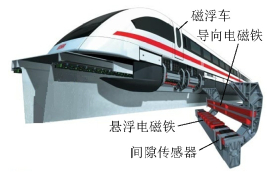
 下载:
下载:

